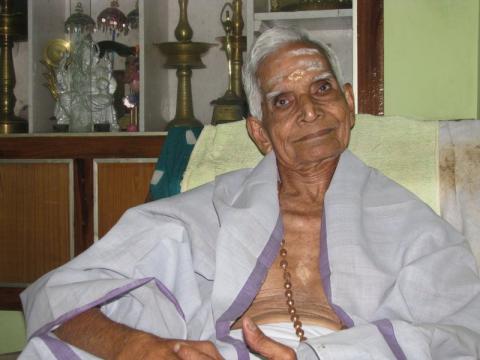Sreevalsan Thiyyadi
August 30, 2013

At 85, Cherthala Thankappa Panickar is among the oldest of Kathakali vocalists and a rare exponent of both schools of the art form. His wrinkled face sports a naughty smile when Cherthala Thankappa Panickar narrates that interesting episode which happened not far from his native place six-and-a-half decades ago. As a musician just out of his teens, Panickar hadn’t formally debuted when a senior Kathakali exponent popped a strange question at the youngster. “You know to count, right? One, two, three, four?” asked actor Thakazhi Kunchu Kurup, as dusk fell at the temple in Kalarkode near Alappuzha. “Yes,” replied Panickar, his mind still groping in the dark. Soon, as the lamp was lit and Santanagopalam was presented, Kurup, as the protagonist Brahmin in the story-play, would slyly point a finger or two backward for Panickar to note how many times he had to sing the line for the gestures to be over. Finally, dawn came and it was clear: Panickar saved the show in the unexpected absence of a top vocalist.
A year after that litmus-test incident, the lanky youth had his proper arangettam — at his neighbourhood Kaliyogam in Varanad. In any case, he had already been training under Thakazhi Kuttan Pillai (who died in 2007, aged 88) and an even more renowned Cherthala Kuttappa Kurup (1914-84). “In the southern school (of Kathakali), one accompanies the lead vocalist, singing shankidi for story-plays in the run-up to actual arangettam. Up north, your first appearance at a show is itself the debut,” clarifies Panickar, now 85, leading a quiet and retired life at his wife’s house near Moovattupuzha in Ernakulam district. Creditably for Panickar, he went on to become an acclaimed vocalist of central Kerala’s Kalluvazhi school as well, courtesy his tutelage under Kalamandalam Neelakantan Nambeesan who redefined 20th-century Kathakali music. That happened for nearly six years when he joined Sadanam Classical Arts Akademi east of Ottapalam in 1956 at a time when Nambeesan was working with the institution. “Those days, the two styles varied thoroughly in approach and essence. The difference starts from Thodayam and Purappad which form the basic lessons,” says Panickar, who Nambeesan first noticed at a Kathakali night in Kumaranalloor off Kottayam in the early 1950s. “I find the Northern genre more methodical and well-laid.” Panickar’s stint in the Palakkad belt ended in 1962 when he was appointed music tutor at RLV College in Tripunithura, south of Kochi. His involvement with both the Kathakali styles, though, continued. “For one, I kept getting stages from North Malabar to South Travancore,” he notes. Two, the RLV classroom itself featured practitioners from varied schools, including the eclectic Kalamandalam Krishnan Nair. Tune-wise, Panickar experimented a lot by introducing ragas less familiar to Kathakali, thanks also to a solid base he had from Carnatic music lessons in childhood. “Further, a five-year Shastri course I did in Sanskrit ensured proper pronunciation and breaking of words in the lyrics,” says the master, whose music was documented in the mid-1980s by (late) classical vocalist-scholar Dr S Ramanathan. The pedantic streak notwithstanding, Panickar is all praise for new-generation Kathakali singers. “They have added commendably to the laya aspect of the art,” observes the veteran, who was instrumental in introducing vocalists Kalamandalam Sankaran Embranthiri and Hyderali down-state during their salad days.
In the evening of his life at rugged Payipra where he lives his post-RLV days since 1983, the skinny Panickar waxes eloquent when he lists out certain achievements other than an array of coveted awards he has won over the years. “I’ve sung in AIR for 47 years. At Varanad temple for 63 years consecutively; at Poornathrayeesa festival (Tripunithura) for 45 years — till 2004,” gushes the artist, who religiously follows the Kerala music scene over the radio. So is it complete sanyas now? “Well,” Panickar clears his throat and says, “I wish I could sing at Cherthala and Tripunithura once last time.”
(The article was published in The Hindu)
0 Comments